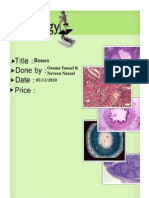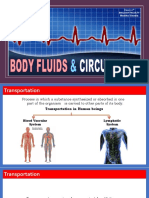Alcohol GEWQK
Alcohol GEWQK
Uploaded by
GEWQKCopyright:
Available Formats
Alcohol GEWQK
Alcohol GEWQK
Uploaded by
GEWQKCopyright
Available Formats
Share this document
Did you find this document useful?
Is this content inappropriate?
Copyright:
Available Formats
Alcohol GEWQK
Alcohol GEWQK
Uploaded by
GEWQKCopyright:
Available Formats
Alcoholism: The Multifaceted Disease GEWQK PSY 201-100 10/14/11 ALCOHOLISM: THE MULTI-FACETED DISEASE The word addiction
conjures up many images: ruined lives, devastating malnourishment, huddled bodies in alleys and thats not nearly all. However, could it be possible for an addiction to be so commonplace, so banal and ordinary, that it goes virtually unnoticed? Alcohol is no simple addiction. It cannot be explained as easily as addictions to cocaine or heroin. Alcoholism is defined as a primary, chronic disease with genetic, psychosocial, and environmental factors influencing its development and manifestations. The disease is often progressive and fatal. It is characterized by impaired control over drinking, preoccupation with the drug alcohol, use of alcohol despite adverse consequences, and distortions in thinking, most notably denial (Morse & Flavin, 1992). There is a huge social factor to consider when determining which types of people will become alcoholics, there is also emerging evidence of genetic factors. When diagnosing and treating alcoholism, these factors can play a key role (Kalat, 2009).
The effects of alcohol on the human body are well known. Almost immediately after the first drink, it starts working inside the brain. Alcohol is absorbed into the bloodstream differently than other substances one might ingest. Its molecules can slip right through the stomach lining and into the bloodstream without having to wait for the digestion process (Bode & Bode, 1997). When solid food enters the stomach, the valve at the bottom of the stomach closes. That valve is called the pyloric sphincter. If a person happens to be drinking on an empty stomach, the pyloric sphincter is wide open and alcohol can pass right through to the
Alcoholism: The Multifaceted Disease small intestine ("Factors that effect," ). In the small intestine, alcohol passes even more rapidly into the bloodstream due to the billions of villi increasing surface volume. Once alcohol enters the bloodstream, there is a thirty-second window before it starts affecting the brain (Bode & Bode, 1997). In the sober brain, there are innumerable multitudes of action potentials occurring at any given time. All of a persons actions depend on whether or not outside stimuli can provide enough excitatory triggers (EPSPs) to cause an action potential on the next neuron (J. Vollaro, PSY 201 Lecture, September 28, 2011). For example, if a friend is wearing something really ugly, the likelihood of a person teasing them because of it depends on several external and internal factors. These factors are, but are not limited to how that persons brain perceives the offensive article of clothing, how naturally outspoken they are, and how much they care about their friends feelings. Their respect for your friend would be an inhibitory trigger (IPSP) and would decrease the chances of them saying something about it. However, if theyve had a few drinks things can change drastically. One of the myriad influences of alcohol on the brain is that it combines with GABA, the brains main inhibitory neurotransmitter, to produce longer effects. The double-negative effect
of an inhibitory neurotransmitter acting on an IPSP is that the likelihood of an individual opening their mouth to speak their mind increases. It is not that they do not care about their ill-fashioned friend. It is simply that the care that person has is inhibited by the alcohol and just cannot catch up with the EPSPs (Kalat, 2009). Ask the average person how long mankind has drank alcohol and their answer will likely be forever. Although that may be hyperbole, there is evidence of alcohol consumption as early as 10,000 BC. Researchers have discovered beer jugs that date back to that pre-historic time
Alcoholism: The Multifaceted Disease (Hanson, 1995). This brings up an obvious, but interesting point. Nearly everybody on the planet will try alcohol at one point in their lives, whether they are predisposed to become alcoholics or not. People also drink for a variety of different reasons. Alcohol stimulates activity at receptors in your brain responsible for both dopamine and opiates. Dopamine is a chemical that is produced in your brain. When dopamine is released, it reinforces the activity that caused the release in the first place. Many activities that the average person finds advantageous (such as productive work, sex, eating) also stimulate dopamine release. As a result, these activities dont necessarily make the individual performing them feel better, but
nevertheless, their desire to engage in them is increased. This dopamine stimulation can account for much of the addicting qualities of alcohol. The relaxing, feel-good effect of a drink comes largely from the opiate stimulation. When opiates bind to dendrites in the brain the effect tends to relax people, decrease their attention to real-world problems, and decrease their sensitivity to pain (Kalat, 2009). What does it mean to be predisposed to alcoholism? This insidious quality lurks in ones genetic code. Genes are the instructions with which your body builds itself. Everything from eye color to intelligence is controlled by your DNA. Clues to a startling amount of ones life can be found in the genetic code right from conception. Researchers are discovering incredible facts about alcoholism much of which has to do with the way ones genes code for the neurotransmitter receptors on their neurons. A study of alcoholics and their offspring revealed that their neurotransmitters differ than other people in their sensitivity. The dopamine receptors in the brain of a human predisposed for alcoholism are less sensitive than the receptors of unaffected humans and thus, these people are less satisfied with normal stimuli such as social interactions. Since alcohol increases activity at these receptors, the potential alcoholic receives
Alcoholism: The Multifaceted Disease
more relaxation from a drink. These people also tend to crave more drinks after having their first of the night. Also in the vein of genetics, some people have a different version of COMT, which is an enzyme responsible for the breakdown of dopamine after its release. Due to one chemical in the COMT being different, there is a huge difference in its effectiveness. The potential alcoholics COMT works much faster and breaks down more dopamine after its release. As stated before, dopamine is important for teaching the body about rewarding behavior. When the dopamine release is sustained, the person will learn that the behavior is beneficial. Behaviors that result in long-term goals tend to result in that type of sustained dopamine release. Because the more efficient COMT does not allow for this, these people tend to ignore long-term goals and focus on instant gratification. Another factor that can be considered is the persons ability to process alcohol. The sons of alcoholics tend to be less intoxicated after drinking. This could be due to a more efficient liver. These people will naturally have less of an adverse reaction to the alcohol and wont be conditioned to avoid heavy drinking. Interestingly, the sons of alcoholics tend to have a smaller amygdala than people without close alcoholic relatives. The amygdala is an area of the brain that is believed to be involved with the way we process others emotions. The amygdala also is believed to be responsible for recalling traumatic experiences. Due to the decreased volume of the amygdala, these potential alcoholics may have trouble determining when their drinking adversely affects others and themselves. They may develop less feelings of regret when looking back on actions taken during an intoxicated state (Stephens & Duka, 2008). Unfortunately, it can be difficult to distinguish alcohol use from abuse. Alcohol use is a societal norm and therefore, an alcoholic can often blend in with a room of people drinking socially. Alcoholics deny their condition to others and to themselves. Abuse can continue unabated for years. The body adapts to alcohol abuse. The liver becomes more effective in
Alcoholism: The Multifaceted Disease processing alcohol, thus developing a metabolic tolerance. In the brain, the receptors for both dopamine and opiates become less sensitive and therefore require more alcohol to receive the same result. The alcoholic also learns to hide their condition from others while continuing to drink. When the term High-Functioning Alcoholic is used, it refers to a person who has completely adapted to their alcoholism and can still maintain a job and relationships. However, these people are not in control of their lives, they need alcohol to function normally and are still prone to destructive behavior. When someone is treated for alcoholism, whether it be their own
idea or at the behest of their family, they are often sent to rehab clinics in order to detoxify. The detoxification process is extremely difficult due to the bodys tolerance and dependence on alcohol. During detox, there is a deficiency of thiamine, a molecule used as an enzyme to break down glucose and provide energy for the nervous system, the heart and the brain. This deficiency can lead to a variety of problems, including tremors, memory loss, extreme discomfort and cardiac arrest. If the alcohol withdrawal is severe, treatment will involve the administration of benzodiazepines. Benzodiazepines work in the brain to decrease severity of withdrawal symptoms by increasing activity at GABA receptors. Thiamine is also injected into the body to aid in metabolism. After two weeks of detox, the worst symptoms are typically over. The patient is kept closely monitored and therapy begins. Group and individual therapy is used but patients are typically released after a few months. They are then urged to attend Alcoholics Anonymous meetings and other forms of counseling (McKinley, 2005). Detox and rehab are not the only options for treatment. There are a few ways to stop alcohol abuse before it becomes dependence. One medication that has been widely used since the 1960s is disulfiram, also known as Antabuse. Disulfiram works by interfering with the metabolism of alcohol. Under normal circumstances, an enzyme known as alcohol
Alcoholism: The Multifaceted Disease dehydrogenase converts alcohol into a toxin known as acetaldehyde. Then, another enzyme known as acetaldehyde dehydrogenase converts the acetaldehyde into acetate, which is then removed from the body. Disulfiram stops the second enzyme from doing its job, resulting in a
buildup of acetaldehyde. This can cause extreme discomfort in the form of nausea, sweating and vomiting. If someone can take disulfiram before they are tempted to drink, the possibility of the adverse reaction will usually be enough to cause abstinence. This is why a placebo version of disulfiram is also found to be equally effective. More recently two drugs have been developed which are effective on a neurochemical level. Naltrexone and nalmefene ignore the metabolic process of alcohol digestion and instead focus on activity in the brain. Naltrexone and nalmefene are known as opioid antagonists. Simply put, these drugs decrease activity at the opioid receptors in the brain. When these drugs are in effect, an individual will not feel the relaxing, positive effects of alcohol due to the opioid block. While naltrexone has been demonstrated to be effective in situations where a subject may be tempted to drink, it does not provide any support for the periods in between drinking, when moderate withdrawal symptoms may occur (O'Connor & O'Malley, 2011). Fortunately, there is a drug that can relieve some of the irritability and the discomfort of withdrawal, while eliminating the need for a rehabilitation clinic. Acamprosate is believed to provide some stability in the neurons in the brain as they revert to the pre-alcoholism levels of excitatory and inhibitory potentials in the dopamine and opiate areas. However, the exact function of the drug is unknown although the structure is similar to the naturally occurring chemical taurine (Swift, 2001). A combination of naltrexone and acamprosate is believed to be an effective treatment plan for recovering alcoholics (MacReady, 2003). There are minimal side effects; some patients report anxiety-related side effects from the naltrexone and the acamprosate can cause mild gastrointestinal disturbances.
Alcoholism: The Multifaceted Disease Treatment is on the market, clinics are welcoming alcoholics into their programs and people are being educated everyday about the signs and symptoms of alcoholism. Sadly, much of it will go untreated due to simple denial, embarrassment or ignorance of the disorder. Many people who dont have the same cravings for alcohol simply cant understand alcoholism, or refuse to classify it as a disease. Some of the difficultly of diagnosis and treatment lies in the many causes of alcoholism. Genetic factors, such as the abnormalities in the opioid/dopamine receptors can be indistinguishable from physiological factors like the decreased volume of the amygdala. Socially, a young persons misguided peers can even unintentionally encourage
alcoholism by admiring their ability to metabolize large amounts of alcohol. Alcohol is a part of society and it seems unlikely to ever be eliminated.
You might also like
- The Subtle Art of Not Giving a F*ck: A Counterintuitive Approach to Living a Good LifeFrom EverandThe Subtle Art of Not Giving a F*ck: A Counterintuitive Approach to Living a Good LifeRating: 4 out of 5 stars4/5 (5945)
- The Gifts of Imperfection: Let Go of Who You Think You're Supposed to Be and Embrace Who You AreFrom EverandThe Gifts of Imperfection: Let Go of Who You Think You're Supposed to Be and Embrace Who You AreRating: 4 out of 5 stars4/5 (1109)
- Never Split the Difference: Negotiating As If Your Life Depended On ItFrom EverandNever Split the Difference: Negotiating As If Your Life Depended On ItRating: 4.5 out of 5 stars4.5/5 (888)
- Hidden Figures: The American Dream and the Untold Story of the Black Women Mathematicians Who Helped Win the Space RaceFrom EverandHidden Figures: The American Dream and the Untold Story of the Black Women Mathematicians Who Helped Win the Space RaceRating: 4 out of 5 stars4/5 (926)
- Grit: The Power of Passion and PerseveranceFrom EverandGrit: The Power of Passion and PerseveranceRating: 4 out of 5 stars4/5 (598)
- Shoe Dog: A Memoir by the Creator of NikeFrom EverandShoe Dog: A Memoir by the Creator of NikeRating: 4.5 out of 5 stars4.5/5 (545)
- The Hard Thing About Hard Things: Building a Business When There Are No Easy AnswersFrom EverandThe Hard Thing About Hard Things: Building a Business When There Are No Easy AnswersRating: 4.5 out of 5 stars4.5/5 (354)
- Elon Musk: Tesla, SpaceX, and the Quest for a Fantastic FutureFrom EverandElon Musk: Tesla, SpaceX, and the Quest for a Fantastic FutureRating: 4.5 out of 5 stars4.5/5 (476)
- Her Body and Other Parties: StoriesFrom EverandHer Body and Other Parties: StoriesRating: 4 out of 5 stars4/5 (831)
- The Emperor of All Maladies: A Biography of CancerFrom EverandThe Emperor of All Maladies: A Biography of CancerRating: 4.5 out of 5 stars4.5/5 (274)
- The Little Book of Hygge: Danish Secrets to Happy LivingFrom EverandThe Little Book of Hygge: Danish Secrets to Happy LivingRating: 3.5 out of 5 stars3.5/5 (419)
- The World Is Flat 3.0: A Brief History of the Twenty-first CenturyFrom EverandThe World Is Flat 3.0: A Brief History of the Twenty-first CenturyRating: 3.5 out of 5 stars3.5/5 (2272)
- The Yellow House: A Memoir (2019 National Book Award Winner)From EverandThe Yellow House: A Memoir (2019 National Book Award Winner)Rating: 4 out of 5 stars4/5 (99)
- Devil in the Grove: Thurgood Marshall, the Groveland Boys, and the Dawn of a New AmericaFrom EverandDevil in the Grove: Thurgood Marshall, the Groveland Boys, and the Dawn of a New AmericaRating: 4.5 out of 5 stars4.5/5 (270)
- The Sympathizer: A Novel (Pulitzer Prize for Fiction)From EverandThe Sympathizer: A Novel (Pulitzer Prize for Fiction)Rating: 4.5 out of 5 stars4.5/5 (122)
- Team of Rivals: The Political Genius of Abraham LincolnFrom EverandTeam of Rivals: The Political Genius of Abraham LincolnRating: 4.5 out of 5 stars4.5/5 (235)
- A Heartbreaking Work Of Staggering Genius: A Memoir Based on a True StoryFrom EverandA Heartbreaking Work Of Staggering Genius: A Memoir Based on a True StoryRating: 3.5 out of 5 stars3.5/5 (232)
- Science A BookANotemakerDocument114 pagesScience A BookANotemakerGrace Xiaopei LuNo ratings yet
- On Fire: The (Burning) Case for a Green New DealFrom EverandOn Fire: The (Burning) Case for a Green New DealRating: 4 out of 5 stars4/5 (75)
- ISE I Sample Paper 1 (With Notes)Document12 pagesISE I Sample Paper 1 (With Notes)The Guardian100% (2)
- The Unwinding: An Inner History of the New AmericaFrom EverandThe Unwinding: An Inner History of the New AmericaRating: 4 out of 5 stars4/5 (45)
- Pathophysiology of StrokeDocument3 pagesPathophysiology of StrokeAqeel Al-Mahdaly0% (1)
- Spinal Cord Injuries Kasun-1Document39 pagesSpinal Cord Injuries Kasun-1kasunswiftNo ratings yet
- Biology Full NotesDocument259 pagesBiology Full NotesthaseiphologoNo ratings yet
- D3.3 Homeostasis HL NotesDocument7 pagesD3.3 Homeostasis HL NotesAnaaya SinghaniaNo ratings yet
- Animal TissueDocument12 pagesAnimal TissuemutiaNo ratings yet
- Colon Neuroendocrine Tumour Synoptic CAPDocument9 pagesColon Neuroendocrine Tumour Synoptic CAPMichael Herman ChuiNo ratings yet
- Lymphatic PDFDocument8 pagesLymphatic PDFJoydee Liza MarcoNo ratings yet
- Patient With Suspected Significant Infection (I.e. Possible Admission)Document2 pagesPatient With Suspected Significant Infection (I.e. Possible Admission)Ryaa Nitaa AdyaaNo ratings yet
- Chlosteral LPTestDocument4 pagesChlosteral LPTestJohn StupNo ratings yet
- Ocular Anatomy Exam I - Answer Key - F' 22 - 23Document8 pagesOcular Anatomy Exam I - Answer Key - F' 22 - 23rittaNo ratings yet
- The Anatomical Record - 2003 - Langevin - Relationship of Acupuncture Points and Meridians To Connective Tissue PlanesDocument9 pagesThe Anatomical Record - 2003 - Langevin - Relationship of Acupuncture Points and Meridians To Connective Tissue PlaneshjakamjNo ratings yet
- Topic3 Extra WorksheetDocument52 pagesTopic3 Extra WorksheetHasan KontyNo ratings yet
- Histology, Lecture 9, Bone (Lecture Notes)Document7 pagesHistology, Lecture 9, Bone (Lecture Notes)Ali Al-Qudsi100% (1)
- Pso-Rite Multi Product How-To Booklet 2021 CompressedDocument90 pagesPso-Rite Multi Product How-To Booklet 2021 CompressedManuel DenizNo ratings yet
- Dentin Hypersensitivity - Etiology, Diagnosis and Treatment A Literature ReviewDocument10 pagesDentin Hypersensitivity - Etiology, Diagnosis and Treatment A Literature Reviewdrgurpal74No ratings yet
- Army - fm21 20 - Physical Fitness TrainingDocument241 pagesArmy - fm21 20 - Physical Fitness TrainingMeowmix96% (23)
- FlatFoot PDFDocument281 pagesFlatFoot PDFJosé Manuel Pena García100% (1)
- Bchm423 Unit 1Document26 pagesBchm423 Unit 1Makeida GuerraNo ratings yet
- Diabetes Melitus (DM) Tipe 2 Di Wilayah Kerja Puskesmas Patrang Kabupaten Jember (The Effect of Diabetes Self-Management Education and SupportDocument8 pagesDiabetes Melitus (DM) Tipe 2 Di Wilayah Kerja Puskesmas Patrang Kabupaten Jember (The Effect of Diabetes Self-Management Education and SupportIda Harya YuliaNo ratings yet
- AbutmentDocument69 pagesAbutmentDevendra Chhonkar100% (2)
- Drug Study: CNS: DizzinessDocument1 pageDrug Study: CNS: Dizzinessmarsh155No ratings yet
- Elaine Rich Kevin Knight Artificial Intelligence SolutionsDocument4 pagesElaine Rich Kevin Knight Artificial Intelligence SolutionsmanimozhiNo ratings yet
- Goljan RR - ImmunopathologyDocument13 pagesGoljan RR - ImmunopathologyShaz ChindhyNo ratings yet
- Ncert Solutions Class 11 Biology Chapter 21 Neural Control and Coordination - 0Document35 pagesNcert Solutions Class 11 Biology Chapter 21 Neural Control and Coordination - 0GajiniNo ratings yet
- PDF Class 11 Body Fluids Circulation BiologyDocument92 pagesPDF Class 11 Body Fluids Circulation BiologyNiharika SharmaNo ratings yet
- Sensory ChangesDocument63 pagesSensory ChangesLara TechiesNo ratings yet
- Continuous Base Identification For Single-Molecule Nanopore DNA SequencingDocument6 pagesContinuous Base Identification For Single-Molecule Nanopore DNA SequencingDonapalaNo ratings yet
- Bio504t Subjectives Best Final Term File 2024 by Sulman AliDocument16 pagesBio504t Subjectives Best Final Term File 2024 by Sulman Alivaciris214No ratings yet






































































